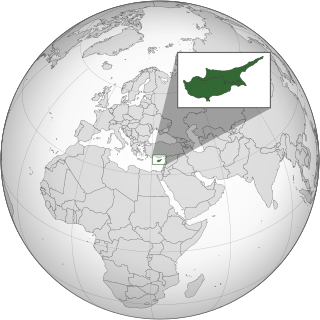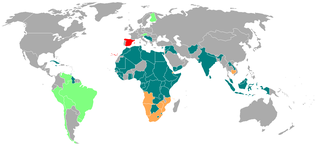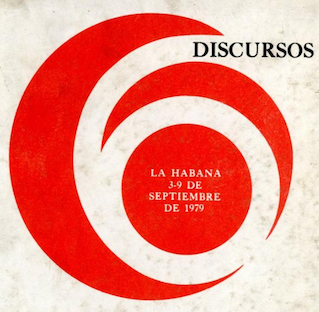
Ibrahim Omar Dabbashi is a Libyan diplomat who formerly served as the Libyan Permanent Representative to the United Nations in New York. Dabbashi led the country's UN mission in opposing the continued rule of Muammar Gaddafi.

Budimir Lončar is a Croatian retired diplomat who served as a Minister of Foreign Affairs of SFR Yugoslavia from 1987 until 1991.

The Socialist Federal Republic of Yugoslavia was one of the founding members of the Non-Aligned Movement. Its capital, Belgrade, was the host of the First Summit of the Non-Aligned Movement in early September 1961. The city also hosted the Ninth Summit in September 1989.

Cyprus–Yugoslavia relations were historical foreign relations between Cyprus and now split-up Socialist Federal Republic of Yugoslavia. Together with Malta, both countries belonged to the small group of European and Mediterranean member states of the Non-Aligned Movement during the Cold War, group which itself part of the larger group of neutral and non-aligned European countries. Two countries shared similar or identical views on many international issues and cooperated closely in the United Nations and at various gatherings of the non-aligned countries. Makarios III participated in the 1961 Summit Conference of Heads of State or Government of the Non-Aligned Movement in Belgrade which was the first official conference of the Non-Aligned Movement.

Yugoslavia–Zambia relations were historical foreign relations between now split-up Socialist Federal Republic of Yugoslavia and Zambia. Relations developed and were focused around shared membership and participation in the Non-Aligned Movement activities. Diplomatic relations between Yugoslavia and Zambia were established on 24 October 1964. They reached their peak before and during the 1970 3rd conference of Heads of State or Government of the Non-Aligned Countries in Lusaka when Yugoslavia provided major logistical and diplomatic support to the relatively recently decolonized Zambia.

Indonesia–Yugoslavia relations were historical foreign relations between now split-up Socialist Federal Republic of Yugoslavia and Indonesia. Both countries were founding member states of the Non-Aligned Movement. Two countries established formal diplomatic relations in 1954. First diplomatic documents were exchanged as early as 1947. Breakup of Yugoslavia, one of the founding and core members of the Non-Aligned Movement, brought into question the very existence of the Movement which was preserved only by politically pragmatic chairmanship of Indonesia.

Summit Conference of Heads of State or Government of the Non-Aligned Movement on 1–6 September 1961 in Belgrade, Yugoslavia was the first conference of the Non-Aligned Movement. A major contributing factor to the organization of the conference was the process of decolonization of a number of African countries in the 1960s. Some therefore called it the ″Third World's Yalta″ in reference to 1945 Yalta Conference.

Third Conference of the Non-Aligned Movement on 8–10 September 1970 in Lusaka, Zambia was the third conference of the Non-Aligned Movement. A preparatory meeting of Foreign Ministers drafted a number of resolutions which were considered by the Summit Conference. President of Zambia Kenneth Kaunda opened the conference by underlining non-alignment as "the natural choice at the time of increased hostility created by ideological conflicts in the bipolar world"

The Non-Aligned Movement (NAM) is a forum of 120 countries that are not formally aligned with or against any major power bloc. After the United Nations, it is the largest grouping of states worldwide.
50th Anniversary Additional Commemorative Non-Aligned Meeting was the 5–6 September 2011 Non-Aligned Movement foreign ministers commemorative meeting which took place in Belgrade, Serbia. The meeting took place in the House of the National Assembly of the Republic of Serbia, building which hosted the 1st Summit of the Non-Aligned Movement on 5–12 June 1961 during the existence of the Socialist Federal Republic of Yugoslavia. The idea for meeting was proposed by the President of Serbia Boris Tadić during his participation at 15th Summit of the Non-Aligned Movement in Sharm el-Sheikh in Egypt. Some 600 delegates, representing over 100 national delegations, attended the meeting.

5th Summit of the Non-Aligned Movement on 16–19 August 1976 in Colombo, Sri Lanka was the conference of Heads of State or Government of the Non-Aligned Movement. 86 nations participated in the summit with additional 30 observers and guests representing all the continents in the world. The Summit is the biggest international conference ever held in Sri Lanka and one of the greatest achievements in its foreign policy. The event took place at the Bandaranaike Memorial International Conference Hall, the first purpose-built conference hall in Asia. It was the first heads of state or government summit of the movement to be organized in Asia. The decisions on the NAM Coordination Bureau organisation and membership conditions were formally defined at the Colombo Summit. The body was to have 25 members and was expected to meet regularly at the United Nations Headquarters in New York City.

9th Summit of the Non-Aligned Movement on 4–7 September 1989 in Belgrade, SR Serbia, SFR Yugoslavia was the conference of Heads of State or Government of the Non-Aligned Movement. Belgrade was the first city to host the Summit for the second time after it hosted the 1st Summit of the Non-Aligned Movement in 1961. Yugoslavia was unanimously selected as the host of the Summit at the 1988 Non-Aligned Foreign Ministers Conference in Nicosia, Cyprus. While the Federal Secretary of Foreign Affairs of Yugoslavia led by Budimir Lončar was excited, the Presidency of Yugoslavia, Yugoslav collective head of state, was skeptical about the prospects of hosting the event but ultimately supported it by Josip Vrhovec in fear that rejection may show the level of the crisis in the country. The comparatively weak federal government organizers of the event ultimately hoped that the conference may convince leaders of the strong Yugoslav federal republics to resolve the early Yugoslav crisis in a constructive and peaceful way, yet it nevertheless escalated in 1991 Yugoslav Wars. The event is therefore sometimes described as the swan song of the prominent Yugoslav Cold War diplomacy. Summit took place at the Sava Centar in New Belgrade. Janez Drnovšek held the opening remarks in Slovenian language.

60th Anniversary Additional Commemorative Non-Aligned Meeting is the 11–12 October 2021 Non-Aligned Movement commemorative meeting taking place in Belgrade, Serbia. The meeting was organized by the Ministry of Foreign Affairs of Serbia, and cohosted with Azerbaijan, in commemoration to the 1st Summit of the Non-Aligned Movement. President Ilham Aliyev made opening speech in a video format. Minister of Foreign Affairs of Serbia Nikola Selaković underlined that his county's strategic and essential goal is membership in the European Union, but that Serbia will not give up on its traditional friends which are not only Russia or China but all member states of the Non-Aligned Movement. While reflecting on historical achievements Indian representative Meenakashi Lekhi invited honest introspection if movement is to keep it's relevance and called unnamed member states to avoid insistence on divisive issues and bilateral score-settling which make NAM increasingly ineffective. Participants prominently criticized vaccine inequity between developed and developing nations.

4th Summit of the Non-Aligned Movement took place on 5–9 September 1973 in Algiers, the capital city of Algeria. The event took place in the Palace of Nations outside of the capital city. The general agenda for the summit was initially defined at the 1973 ministerial meeting in Kabul where Algerian delegation welcomed primary contribution of Guyana, India and SFR Yugoslavia. 76 countries in total participated in the summit calling upon the United States and the Soviet Union not to take important decisions on disarmament, world trade or the world monetary system without the effective participating on the Third World.

6th Summit of the Non-Aligned Movement took place on 3–9 September 1979 in Havana, the capital city of Cuba. 93 countries took part in the summit. It was the first NAM summit which took place in one Iberoamerican country. The event was marked by political and ideological divisions among the non-aligned countries. The organizer wanted to use the event to propose "a natural alliance" between the movement and the Eastern Bloc causing strong resistance from some members, particularly SFR Yugoslavia. While both Cuba and Yugoslavia were at the time nominally socialist states, they took substantially different position in world politics with Cuba perceiving United States, and Yugoslavia Soviet Union as a threat to its independence.
1973 Non-Aligned Movement Standing Committee Conference took place on 13-15 May 1973 in Kabul, the capital city of Afghanistan. The country participated in the work of the movement since the 1st Summit of the Non-Aligned Movement in Belgrade in 1961. Afghanistan perceived Non-Alignment as a guaranty of peace in independence in the context in which the country shared a long border both with Soviet Union and CENTO member states. The 1973 meeting was opened by the Minister of Foreign Affairs of Afghanistan Mohammad Musa Shafiq. While serving as a host country, Afghanistan decided to nevertheless play marginal role in the event concerned how its more prominent role may be perceived by major powers. Delegation of Sri Lanka proposed Colombo as the host of the 5th Summit of the Non-Aligned Movement which was strongly supported by SFR Yugoslavia. Panama joined the NAM as an observer, while Bangladesh, despite reservations by Pakistan, joined as a full member state. Yugoslavia supported unofficial interest by Australia and North Korea to attend the next meeting with observer status. India, Guyana and SFR Yugoslavia played particularly active role in preparation of the working materials for the following summit in Algeria. Chile proposed inclusion of discussion on measures against global corporate threats and measures to protect sovereign control over natural resources. In July of the same year the host country was faced with 1973 Afghan coup d'état after which the new authorities stated their intention to maintain country's non-aligned position.

8th Summit of the Non-Aligned Movement on 1-6 September 1986 in Harare, Zimbabwe was the conference of heads of state or government of the Non-Aligned Movement. 101 countries took part in the summit, 51 of which were African countries. Explicitly expressed South–South cooperation call appeared for the first time in the 1986 NAM final declaration.
10th Summit of the Non-Aligned Movement on 1–6 September 1992 in Jakarta, Indonesia was the conference of Heads of State or Government of the Non-Aligned Movement. Around 100 delegations, including some 60 heads of State or government, participated in the Summit in Jakarta.

1978 Non-Aligned Foreign Ministers Conference was held in Belgrade, SR Serbia, SFR Yugoslavia, between 25 and 30 July 1978. The conference was organized as a preparatory event ahead of the divisive 6th Summit of the Non-Aligned Movement which took place in Havana next year. The NAM member states were deeply divided over Cuban military actions in Africa and country's pro-Soviet politics with some of them threatened to boycott the Summit in Havana. The host country of Yugoslavia was recognized as the leader of the middle ground delegations which wanted to overcome divisions and radicalism and was in this effort supported primarily by India, Sri Lanka and Indonesia.

Mediterranean island country of Cyprus was one of the founding members of the Non-Aligned Movement with Makarios III attending the 1st Summit of the Non-Aligned Movement in Belgrade, SFR Yugoslavia in 1961, just one year after the Cypriot independence. Membership in the movement was perceived as one of two major foreign policy alternatives with the first one being formal membership in NATO at least nominally supported by both Greece and Turkey in the initial period after the London and Zürich Agreements and second one being pro-western participation in Non-Aligned Movement where United Kingdom and United States preferred this option at least until 1963.



















